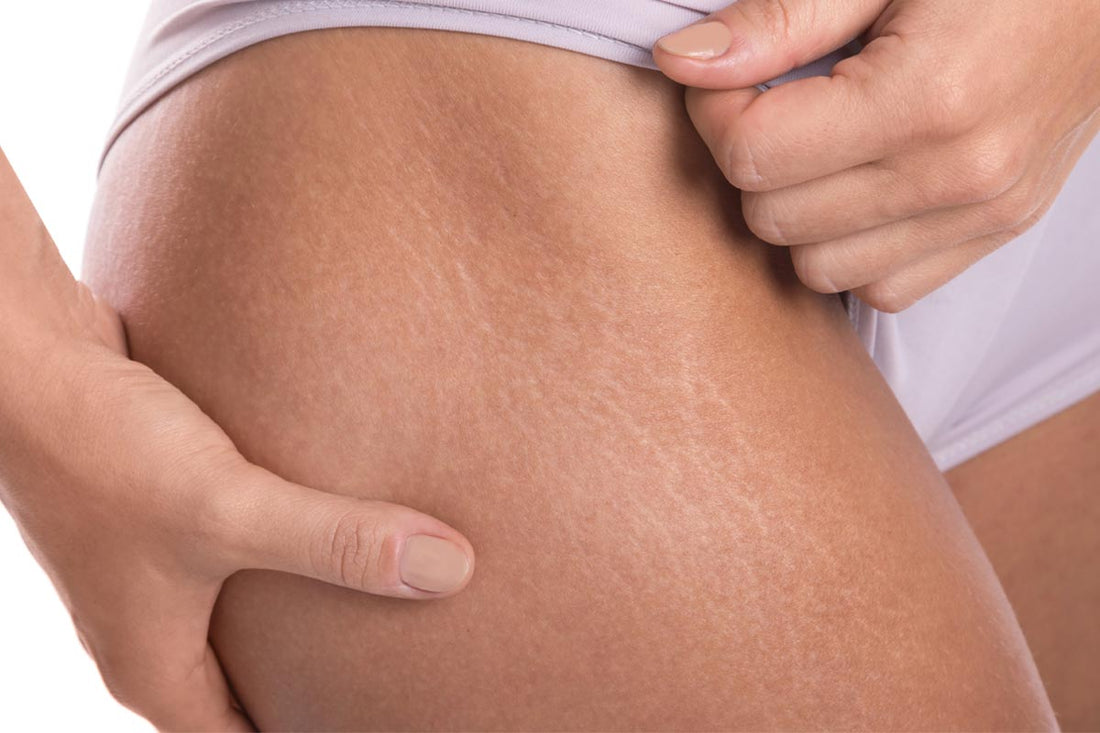
How to Prevent and Treat Stretch Marks
Share
Stretch marks are unsightly lines that appear on the body, commonly found on the abdomen, breasts, hips, and buttocks, although they can appear anywhere. Stretch marks appear when weight gain is rapid, and the skin stretches and "tears," unable to return to its normal state.
To understand them more easily, I like to compare stretch marks to a plastic grocery bag. If you take a plastic bag and stretch it, it gives a little, but it never returns to its normal state. If you look closely, you'll see that you've left some lines due to stretching. The same thing happens to skin. When skin is overstretched, the collagen and elastin that provide support and elasticity break down, giving rise to the characteristic lines.
GUYS:
Not all stretch marks are the same . They depend on how long it's been since they appeared, your skin type, and their color:
- Stripes or lines that appear on the abdomen, breasts, hips, buttocks, or other parts of the body.
- Stripes of pink, red, black, blue or purple.
- Bright stripes that fade to a lighter color.
- Stripes that cover large areas of the body.
Anyone can develop stretch marks, but some factors increase your likelihood of having them , such as:
- Being a woman
- Having a personal or family history of stretch marks
- Being pregnant, especially if you are young
- Present accelerated growth in adolescence
- Having accelerated weight gain or loss
- Taking corticosteroids
- Having breast enlargement surgery
- Exercising and taking anabolic steroids
- Having a genetic disorder, such as Cushing's syndrome or Marfan syndrome
In its evolution, two phases can be distinguished: inflammatory and scarring.
Inflammatory phase
It occurs when the stretch mark begins, has a slightly purplish color and is soft to the touch.
Scarring phase
These are stretch marks that have been present for some time, and the lesion has evolved toward its permanent appearance. A depression develops, and they acquire a scar-like white color.
Treatment:
Before starting treatment, you should consider the length of time the stretch mark has developed, as the chances of success vary drastically depending on its appearance.
The best thing we can do to treat stretch marks is to prevent them. If they have already formed, the sooner we start treatment, the greater the chances of success. The stage when stretch marks have a purplish or purple color is when you should start treating them. If you wait until the stretch mark has already healed (white color), treatment will no longer be effective.
Treatment in the inflammatory phase (red and bluish stretch marks)
Good results can be achieved with appropriate treatment, provided that weight and volume are returned to normal.
The application of products that stimulate the formation of glycosaminoglycans in collagen and elastin fibers is recommended, activating tissue regeneration, providing restorative active ingredients that replace altered structures, and improve tissue oxygenation and hydration.
Both pharmacological and dermocosmetic treatments are not very effective in eliminating atrophic stretch marks, so the best thing to do is to prevent them.
The recommended anti-stretch mark products at this stage are those that contain the following substances:
Hydrolyzed collagen and elastin . Improves tissue consistency and elasticity.
Asiaticosides . From centella asiatica extract, they improve the appearance and progression of stretch marks.
Hyaluronic acid . Improves hydration and oxygenation of the dermis.
Placental extracts . Stimulates metabolism and cellular respiration, promoting the regeneration of injured tissues.
Vitamins A, B, C, D, E, and wheat germ oil . They exert regenerative, protective, and moisturizing activity at the dermoepidermal level.
In the scarring phase
There is no effective clinical treatment to eliminate stretch marks once they form, especially if they are in their scarring phase.
Preventive treatment
We already know that there are many causes of stretch marks, such as pregnancy, weight gain or loss, or cellulite. The most important thing to keep in mind is that once a stretch mark has formed, it can't be cured; the only thing we can do is prevent it.
The formation of stretch marks depends on the condition of the skin. We must use products designed to improve skin elasticity and resist the influence of hormonal changes we experience throughout our lives.
Topical products serve both to prevent stretch marks and to slow their development. And just as important as their use is their application method, as these products will not be effective without proper use.
A light but prolonged massage should be performed, as this helps increase local microcirculation, thereby increasing the supply of nutrients and water that the body itself cannot provide. This reduces the likelihood of stretch marks forming.
Another tip for preventing stretch marks is to stimulate blood circulation with massage and physical exercise, avoiding excessive sun exposure and swimming in pools, as these dry out the skin or damage it with strong elements like chlorine.
During pregnancy we should use specific products that prevent the formation of stretch marks.
It's not enough to apply any moisturizer to prevent the appearance; we must use products specially designed for prevention so that the skin can resist the factors that cause it to appear.
Remember, prevention is the most important thing, but if any stretch marks still appear, you should treat them as soon as possible before they heal, since once the stretch mark has healed, treatments are no longer effective.
